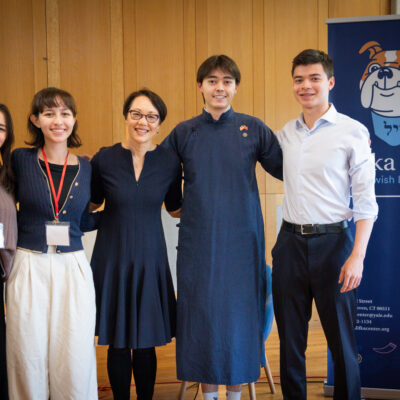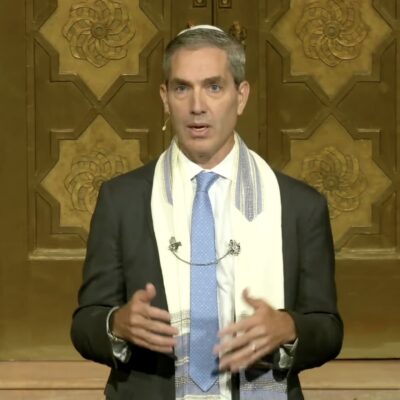How Many Jewish Undergraduates?

By Leonard Saxe, Michelle Shain, Graham Wright and Shahar Hecht
According to Hillel’s College Guide, if you are a student looking for a university with a large Jewish population, your #1 choice is the University of Florida (UF), flagship campus of the Florida state system. Hillel lists UF as having 6,500 Jewish undergraduates, nearly 20% of the total undergraduate population at the Gainesville campus. But in a study we conducted this spring of the views of ethnic and religious groups among UF students, we found only 2,300 Jewish students (7% of the total), more than 4,000 fewer than indicated by the Guide.
We are confident that our findings reflect reality and that there are fewer Jewish students at UF than Hillel reported. We used “gold standard” methodology – surveying a random sample of a university-supplied list of all undergraduate students. A comparison of our data with information provided by the university indicates that we accurately estimated the number of racial and ethnic minorities and the proportion of international students. To ensure that we did not overlook religiously unengaged Jews, we asked students for their religion and whether they considered themselves Jewish aside from religion; then, we asked about their parents’ religious identities. Students who considered themselves Jewish in any way were counted in our estimates.
UF is the latest of five campuses we have studied over the last two years (methodology). On each, we found fewer Jewish students than the Hillel Guide claimed. Although the UF survey yielded the largest discrepancy, the patterns across schools are similar. The undergraduate student bodies at Harvard University and the University of Pennsylvania were thought to be 25% Jewish in 2016, yet our surveys found only 14% and 16%, respectively. (Based on our findings, Hillel’s estimates for these two schools have since been updated.) At the University of Michigan, where the student body was described as 16% Jewish, we found 12%. At Brandeis University in 2016 we found that only 35% of the student body identified as Jewish, compared to the 50% listed in the Hillel Guide at the time.
The Hillel Guide’s estimates are implausibly high across the board, and not just at these five campuses. The best data about the American Jewish population (the 2013 Pew study of American Jews and the ongoing American Jewish Population Project) indicate that there are approximately 90,000 Jews in each age cohort. If we generously assume that 80% of Jews attend college, then there should be no more than 290,000 Jewish college students on all US campuses combined. Adding up the Hillel Guide’s online estimates of Jewish undergraduates at just the 450 schools for which estimates are provided, suggests that there are nearly 290,000 Jewish students on these campuses. Although these estimates may seem consistent, the Hillel Guide total does not include nearly 200 additional campuses Hillel claims to serve but for which it has no published estimates of the numbers of Jewish students on campus. In addition, some campuses with Jewish students do not appear in the Guide.
One source of evidence about the size of the Jewish student population at colleges that do not have Hillel estimates is from Birthright Israel. In 2017, over 18,000 US undergraduate students from 700 US campuses participated in the program. More than 10% of these students came from 300 schools that Hillel does not list in its guide or for which it has no estimates of the number of Jewish students. For example, in 2017, Santa Monica College, for which Hillel has no estimate, sent 139 students on a Birthright trip.
Application data to Birthright Israel also likely underestimate the number of Jewish students at less traditionally “Jewish” destination schools. Interest in Birthright develops through word of mouth among Jewish students and through the efforts of recruiters like Hillel (with staff on approximately 170 campuses). Jewish students at campuses with few Jewish peers and little or no Jewish presence are less likely to apply to Birthright.
If Jewish students are dispersed among a larger group of schools than previously thought, why does this matter? Accurate data about the number and character of Jewish students on individual campuses are essential for organizational and communal planning. These data help allocate resources effectively, assess the success of programs, and potentially influence students’ decision-making about where to attend college.
Although they may appear surprising and even troubling, our findings are actually good news. If organizations like Hillel have been overestimating the number of Jewish students on many campuses, then they have also been underestimating their effectiveness in reaching Jewish students there. In fact, they have been attracting a larger portion of their campus’s Jewish population than previously thought.
At the same time, if Jewish college students are more dispersed than previously believed, Jewish groups may need to expand their reach. These students may be more difficult to identify and may have weaker Jewish backgrounds. Engagement efforts with these students may require different approaches than those used at schools with larger Jewish student bodies.
Knowing the number of Jewish students on a campus, even coupled with information about students’ Jewish educational backgrounds and identities, does not tell us all we need to know about how to enhance opportunities for their Jewish learning and involvement with the community. But accurate data are an important foundation and help lay the groundwork for strategies to better understand and engage the next generation of Jewish adults.
[Hillel’s response can be found here.]
Leonard Saxe is Klutznick Professor of Contemporary Jewish Studies at Brandeis University and Director of the Cohen Center for Modern Jewish Studies and the Steinhardt Social Research Institute.
Michelle Shain is an associate research scientist at the Cohen Center for Modern Jewish studies at Brandeis University.
Graham Wright is an associate research scientist at the Cohen Center for Modern Jewish studies at Brandeis University and teaches statistics and research methods at Brandeis University and Framingham State University.
Shahar Hecht is a senior research associate at the Cohen Center for Modern Jewish studies at Brandeis University.

 Add EJP on Google
Add EJP on Google









